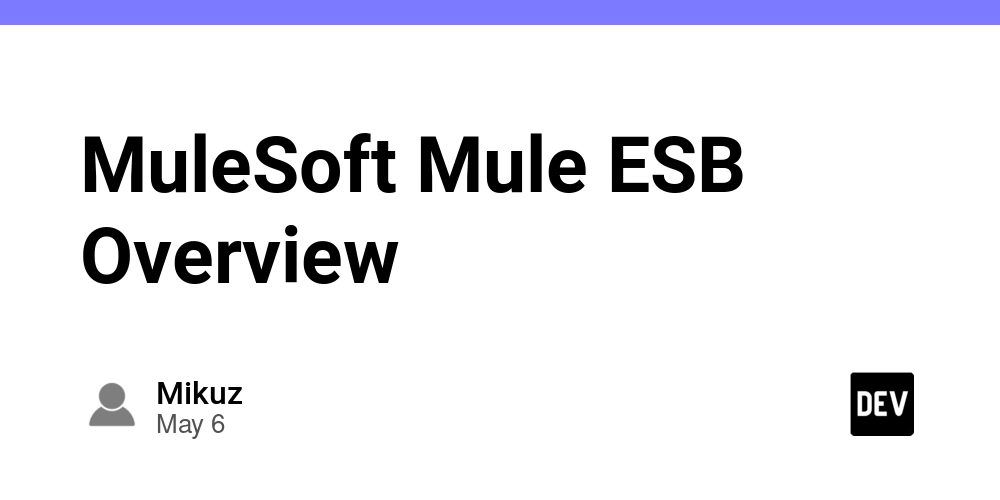MuleSoft Mule ESB Overview
In today's interconnected business landscape, organizations face significant challenges integrating multiple software systems and applications. MuleSoft Mule ESB emerges as a powerful middleware solution that addresses these integration hurdles by acting as a central communication hub. This enterprise service bus technology enables organizations to connect diverse systems, applications, and data sources through a unified platform. As part of the Anypoint Platform, MuleSoft ESB provides comprehensive tools for connecting everything from modern SaaS applications to legacy systems, offering a structured and scalable approach to enterprise integration. The platform's ability to handle complex data transformations, multiple protocols, and secure communications makes it an essential tool for businesses pursuing digital transformation initiatives. Understanding MuleSoft ESB Fundamentals Core Architecture MuleSoft ESB functions as a sophisticated integration framework that establishes reliable connections between disparate enterprise systems. It operates as a centralized message broker, orchestrating data flow between applications while maintaining data integrity. The architecture supports both synchronous and asynchronous communication patterns. Integration Capabilities Through its event-driven architecture, MuleSoft processes messages and events in real-time, supporting: Content-based routing Message filtering Advanced data transformations These features ensure consistent and efficient data flow between systems. Protocol Support MuleSoft ESB supports a wide range of communication protocols: HTTP/HTTPS – Web integrations JMS – Reliable messaging FTP/SFTP – File transfers SOAP and REST – Web services Database protocols – Direct data access Deployment Flexibility Organizations can choose from various deployment models: On-premises – For maximum control Cloud-based – For scalability Hybrid – For balanced flexibility Multi-cloud – For distributed systems Development Environment Using Anypoint Studio, developers create and manage integration flows with: Visual design tools Debugging and testing features Modular architecture and reusable components Key Benefits and Advantages of MuleSoft ESB Enhanced Connectivity Options With a vast connector library, MuleSoft simplifies integration with: Salesforce SAP Oracle Other popular platforms This reduces integration time and the need for custom development. Performance and Scalability Key features include: Horizontal scaling Load balancing High availability & fault tolerance Real-time processing of large datasets Development Efficiency MuleSoft's API-first approach and DataWeave transformation language enable: Reusable integration assets Simplified data mapping Efficient collaboration in Anypoint Studio Security Framework Security is built-in with: Authentication mechanisms Role-based access control (RBAC) End-to-end encryption Secure API gateway Compliance with security standards Monitoring and Management MuleSoft provides: Real-time performance metrics Analytics dashboards Integration with existing monitoring tools AI-powered analytics for optimization Essential Capabilities of MuleSoft ESB Service Orchestration MuleSoft coordinates complex workflows across systems, supporting: Real-time and batch processing Parallel execution Conditional logic and routing Data Transformation Services Using DataWeave, MuleSoft supports: XML, JSON, CSV conversions Complex mapping rules Streaming transformations Large dataset processing Protocol Bridging Acts as a universal translator between: REST & SOAP services Message queues (JMS, AMQP) File and database-based integrations Service Mediation Features include: API versioning Service virtualization Dynamic routing Message filtering and error recovery Governance and Compliance MuleSoft ensures governance through: OAuth and JWT support RBAC and secure transactions Audit logging and monitoring Compliance with industry regulations Conclusion MuleSoft ESB is a robust integration solution addressing modern enterprise connectivity challenges. It offers: Scalable and secure architectures Reusable connectors and components Advanced orchestration and transformation capabilities Built-in security and monitoring While implementation requires careful planning, the long-term benefits of: Reduced development time Enhanced system connectivity Improved operational efficiency ...make MuleSoft ESB a valuable asset for organizations undergoing digital transformation. As businesses evolve, MuleSoft's continuously growing feature set ensures it remains a future-ready integration platform, supporting agile, scalable

In today's interconnected business landscape, organizations face significant challenges integrating multiple software systems and applications. MuleSoft Mule ESB emerges as a powerful middleware solution that addresses these integration hurdles by acting as a central communication hub. This enterprise service bus technology enables organizations to connect diverse systems, applications, and data sources through a unified platform.
As part of the Anypoint Platform, MuleSoft ESB provides comprehensive tools for connecting everything from modern SaaS applications to legacy systems, offering a structured and scalable approach to enterprise integration. The platform's ability to handle complex data transformations, multiple protocols, and secure communications makes it an essential tool for businesses pursuing digital transformation initiatives.
Understanding MuleSoft ESB Fundamentals
Core Architecture
MuleSoft ESB functions as a sophisticated integration framework that establishes reliable connections between disparate enterprise systems. It operates as a centralized message broker, orchestrating data flow between applications while maintaining data integrity. The architecture supports both synchronous and asynchronous communication patterns.
Integration Capabilities
Through its event-driven architecture, MuleSoft processes messages and events in real-time, supporting:
- Content-based routing
- Message filtering
- Advanced data transformations
These features ensure consistent and efficient data flow between systems.
Protocol Support
MuleSoft ESB supports a wide range of communication protocols:
- HTTP/HTTPS – Web integrations
- JMS – Reliable messaging
- FTP/SFTP – File transfers
- SOAP and REST – Web services
- Database protocols – Direct data access
Deployment Flexibility
Organizations can choose from various deployment models:
- On-premises – For maximum control
- Cloud-based – For scalability
- Hybrid – For balanced flexibility
- Multi-cloud – For distributed systems
Development Environment
Using Anypoint Studio, developers create and manage integration flows with:
- Visual design tools
- Debugging and testing features
- Modular architecture and reusable components
Key Benefits and Advantages of MuleSoft ESB
Enhanced Connectivity Options
With a vast connector library, MuleSoft simplifies integration with:
- Salesforce
- SAP
- Oracle
- Other popular platforms
This reduces integration time and the need for custom development.
Performance and Scalability
Key features include:
- Horizontal scaling
- Load balancing
- High availability & fault tolerance
- Real-time processing of large datasets
Development Efficiency
MuleSoft's API-first approach and DataWeave transformation language enable:
- Reusable integration assets
- Simplified data mapping
- Efficient collaboration in Anypoint Studio
Security Framework
Security is built-in with:
- Authentication mechanisms
- Role-based access control (RBAC)
- End-to-end encryption
- Secure API gateway
- Compliance with security standards
Monitoring and Management
MuleSoft provides:
- Real-time performance metrics
- Analytics dashboards
- Integration with existing monitoring tools
- AI-powered analytics for optimization
Essential Capabilities of MuleSoft ESB
Service Orchestration
MuleSoft coordinates complex workflows across systems, supporting:
- Real-time and batch processing
- Parallel execution
- Conditional logic and routing
Data Transformation Services
Using DataWeave, MuleSoft supports:
- XML, JSON, CSV conversions
- Complex mapping rules
- Streaming transformations
- Large dataset processing
Protocol Bridging
Acts as a universal translator between:
- REST & SOAP services
- Message queues (JMS, AMQP)
- File and database-based integrations
Service Mediation
Features include:
- API versioning
- Service virtualization
- Dynamic routing
- Message filtering and error recovery
Governance and Compliance
MuleSoft ensures governance through:
- OAuth and JWT support
- RBAC and secure transactions
- Audit logging and monitoring
- Compliance with industry regulations
Conclusion
MuleSoft ESB is a robust integration solution addressing modern enterprise connectivity challenges. It offers:
- Scalable and secure architectures
- Reusable connectors and components
- Advanced orchestration and transformation capabilities
- Built-in security and monitoring
While implementation requires careful planning, the long-term benefits of:
- Reduced development time
- Enhanced system connectivity
- Improved operational efficiency
...make MuleSoft ESB a valuable asset for organizations undergoing digital transformation.
As businesses evolve, MuleSoft's continuously growing feature set ensures it remains a future-ready integration platform, supporting agile, scalable, and maintainable integration strategies.






































































































































































![[The AI Show Episode 146]: Rise of “AI-First” Companies, AI Job Disruption, GPT-4o Update Gets Rolled Back, How Big Consulting Firms Use AI, and Meta AI App](https://www.marketingaiinstitute.com/hubfs/ep%20146%20cover.png)

















































































































































































.jpg?width=1920&height=1920&fit=bounds&quality=70&format=jpg&auto=webp#)






















































































_Alexey_Kotelnikov_Alamy.jpg?width=1280&auto=webp&quality=80&disable=upscale#)
_Brian_Jackson_Alamy.jpg?width=1280&auto=webp&quality=80&disable=upscale#)



 Stolen 884,000 Credit Card Details on 13 Million Clicks from Users Worldwide.webp?#)


























































































![Roku clarifies how ‘Pause Ads’ work amid issues with some HDR content [U]](https://i0.wp.com/9to5google.com/wp-content/uploads/sites/4/2025/05/roku-pause-ad-1.jpg?resize=1200%2C628&quality=82&strip=all&ssl=1)

![Look at this Chrome Dino figure and its adorable tiny boombox [Gallery]](https://i0.wp.com/9to5google.com/wp-content/uploads/sites/4/2025/05/chrome-dino-youtube-boombox-1.jpg?resize=1200%2C628&quality=82&strip=all&ssl=1)













![Apple Seeds visionOS 2.5 RC to Developers [Download]](https://www.iclarified.com/images/news/97240/97240/97240-640.jpg)
![Apple Seeds tvOS 18.5 RC to Developers [Download]](https://www.iclarified.com/images/news/97243/97243/97243-640.jpg)





































































































